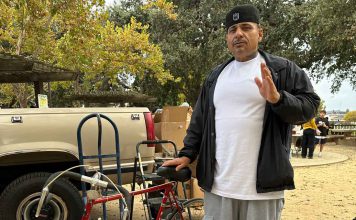It’s time for our annual call: please bring me a pie
… or two. Each year, Jenny’s Kitchen readers provide all of the
pies for the Lord’s Table’s annual Thanksgiving dinner. The dinner
is attended by people from all walks of life: families with
children, homeless people, lonely people and some who have hit a
bad run of luck or have lost their jobs. T
his year, the tables are expected to be especially full, since
both the Salvation Army and the Red Cross have closed.
It’s time for our annual call: please bring me a pie … or two. Each year, Jenny’s Kitchen readers provide all of the pies for the Lord’s Table’s annual Thanksgiving dinner. The dinner is attended by people from all walks of life: families with children, homeless people, lonely people and some who have hit a bad run of luck or have lost their jobs. This year, the tables are expected to be especially full, since both the Salvation Army and the Red Cross have closed.
Years ago, store-bought pumpkin pies were purchased from local grocery stores. For the past six years, however, there has been a healthy mix of homemade apple, juicy peach, homemade pumpkin and berry pies, all provided by generous readers. The variety has been astounding and I am always amazed at how much effort readers will put into baking a pie for someone they don’t know. Pies come from retirees, school teachers, entire classes, youth groups, Girl Scout troops and my nice readers, neighbors and friends.
Due to this incredible generosity, my kitchen, dining room and living room used to be filled with hundreds of pies, which we usually delivered in several trips in the rain. Because of the abundance of donations, we have moved the collection site to the Lord’s Table, in the gym of St. Mary School at 11 First Street in Gilroy. Pies will be accepted from 3pm to 7pm on the Wednesday before Thanksgiving, Nov. 26.
In the meantime, however, I would like to get a count of how many readers will be bringing pies. As always, I am very grateful for whatever you can do. If you just can’t find time to bake a pie, I would love to receive store-bought. If you are able to bake one at home, it will be so appreciated by the many guests at the Lord’s Table Thanksgiving Dinner.
Please e-mail your pledges to jd****@****ic.com or give me a call at (408) 842-9028. Give me your name and the number of pies you can bring. Thank you in advance for your kindness!
Happy Cooking!
• This is a pie week, so here are some recipes for you to try. You can either use store bought crusts or try the basic recipe at the end of the column. Test these pies on your
ing your own: If you want to bake your own pie crust, try this recipe. It’s by Sheila Lukins, “Silver Palate” cookbook author.
Sheila’s Basic
Pie Crust
2 1/2 cups unbleached all-purpose flour
1/2 teaspoon salt
12 tablespoons (1 1/2 sticks) cold unsalted butter, cut into tablespoon-size pieces
1/2 cup cold shortening
1/4 to 1/2 cup ice cold water
Step 1: Combine the flour and salt in a large bowl. Add the butter and mix together with your fingertips or a pastry cutter until the mixture is very coarse – the size of peas. Then add the shortening, and continue blending with fingertips. The mixture should still be very coarse.
Step 2: Add 4 tablespoons of the water and toss the mixture together. If the dough does not hold together when gathered in your hand, add a bit more water. Do not overwork the dough. Divide the dough in half and form it into thick disks. Wrap each disk in plastic and chill for at least 1 hour or overnight.
Step 3: Remove one disk of dough from the refrigerator. Unwrap it and roll it out on a lightly floured work surface or between two sheets of wax paper to form a circle about 1/8-inch thick and 2 inches larger than the pie plate. Work quickly, as the dough can become sticky. Use a spatula to help lift the dough, and fold it loosely in half and into quarters. Gently transfer it to the pie plate, centering the corner of the dough in the center of the pie plate. Open up the dough and press it lightly into the plate to fit. If the dough should tear, just press it gently together. Trim the dough, leaving a 1-inch overhang. If making a single-crust pie, turn the edge under and flute it decoratively.
Step 4: Repeat the rolling for a top crust or for another bottom crust. The circle of a top crust should be 9 inches for an 8-inch pie and 10 inches for a 9-inch pie.
Step 5: Follow the individual pie recipes for filling and baking. Makes enough for an 8- or 9-inch double-crust pie, or 2 single-crust pies.
family and then make them for Pledge-a-Pie. I’ll bet no one will complain about being a taste-tester.
Lemon Custard Pie
Filling:
6 large eggs
1 cup sugar
1 cup fresh lemon juice
4 large egg yolks
2 tablespoons grated lemon peel
1 cup (2 sticks) unsalted butter, cut into pieces
1/2 cup half and half
1 tablespoon vanilla extract
Whipped cream (optional)
Lemon slices (optional)
Fresh mint (optional)
For Filling:
Step 1: Combine first five ingredients in heavy large saucepan and whisk to blend. Add butter. Whisk over medium heat until filling thickens and leaves path on back of spoon when finger is drawn across, about 13 minutes (do not boil).
Step 2: Mix in half and half and vanilla. Whisk until filling is very thick and smooth and just begins to bubble, about 6 minutes. Transfer to bowl. Cool 15 minutes, stirring occasionally. Cover; chill until very cold, about 4 hours. (Can be made 3 days ahead. Keep chilled.)
For Crusts:
Step 1: You will need two discs of pie dough.
Step 2: Preheat oven to 375°F. Roll out 1 dough disk on lightly floured surface to 12-to 13-inch round. Transfer dough to 9-inch glass pie plate. Trim overhang to 1/2 inch; reserve dough scraps. Fold edge of dough under and crimp decoratively. Repeat rolling with second dough disk; put into another 9-inch glass pie plate. Freeze until firm, about 10 minutes.
Step 3: Line crusts with foil; fill with dried beans or pie weights. Bake crusts until sides are set, about 20 minutes. Remove foil and beans. Continue to bake until crusts are pale golden, piercing with toothpick if crusts bubble, about 12 minutes. Cool crusts completely on racks. Maintain oven temperature.
Step 4: Roll out dough scraps on floured surface to 1/8-inch thickness. Transfer to baking sheet. Bake until golden, about 10 minutes. Cool. Maintain oven temperature. Crumble pastry into small pieces; wrap and reserve at room temperature.
Step 5: Spoon half of filling into each crust. Bake until filling is set in center, about 18 minutes. Cool pies. Chill until cold, about 2 hours. (Can be made 1 day ahead. Cover and keep chilled.) Sprinkle crumbled pastry over pies. Garnish pies with whipped cream, lemon slices and mint, if desired.
Makes 2 pies.
Grandma’s Priceless Pumpkin Pie
Filling:
3 cups solid pack pumpkin (about 1 1/2 16-ounce cans)
1 1/2 cups sugar
1 1/2 cups whipping cream
1 1/4 cups milk
6 tablespoons all
purpose flour
3 large eggs
3 tablespoons dark molasses
1 tablespoon ground
cinnamon
3/4 teaspoon ground
allspice
3/4 teaspoon salt
For Crust:
Step 1: You will need two discs of dough.
Step 2: Preheat oven to 350°F. Line crusts with foil; fill with dried beans or pie weights. Bake crusts until sides begin to set, about 15 minutes. Remove foil and beans. Bake crusts until pale golden, piercing with toothpick if crusts bubble, about 15 minutes. Cool completely on racks. Maintain oven temperature.
For filling:
Step 1: Whisk all ingredients in large bowl to blend. Pour half of pumpkin filling (about 3 3/4 cups) into each prepared pie crust.
Step 2: Bake pies until filling is set in center, about 1 hour. Cool pies on racks. Makes two 9-inch pies.
Notes:
• Note to reader Dina: I am looking for that bread recipe! Hopefully, I’ll find it by next week.
• Do you know which tastes stronger, curly-leaf parsley or flat-leaf (Italian) parsley? The Italian is the more pungent herb. When chopping parsley, dry the herb thoroughly before beginning. It makes the job much easier.
• Whether buying fresh or dried pasta, read the label and only buy brands made with durum wheat (also called Semolina). This is the preferred pasta because it absorbs less water, has a mellow flavor and retains a pleasant bite when cooked.
• Cutting into a piece of steak to see if it’s done can let the juices out. With practice, you can tell when a steak’s done. Press the meat with your finger. If it’s soft, the meat is rare. If it pokes in but then bounces back, it’s medium. If it is quite firm, it’s well done.
• Note to reader Al: Thank you for your pre-pledge of two pies. I am so grateful!











